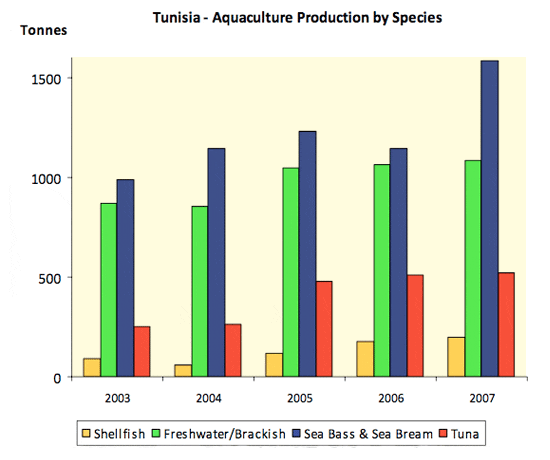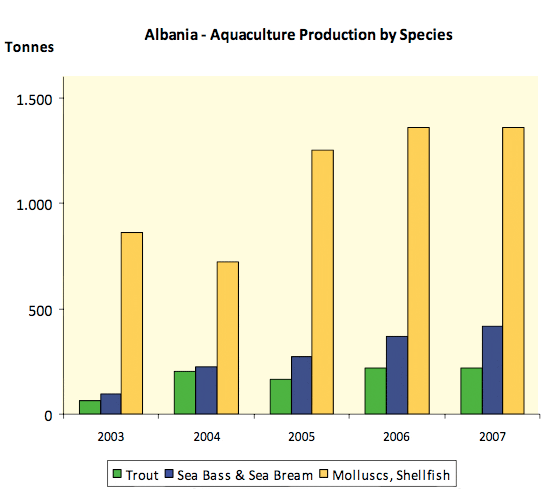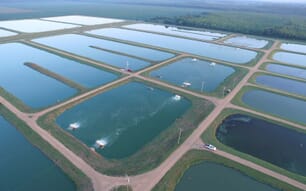Tunisia
In 1994 Tunisia drafted a strategic development plan for aquaculture identifying appropriate sites and necessary raw material inputs estimating an annual production potential of 20 000 tonnes from aquaculture, including marine, freshwater and brackish fish, mussels, shrimp and algae. Despite this prediction and various incentives to promote the growth of the sector, aquaculture production reached only 3 366 tonnes in 2007, about three per cent of the total annual fisheries production. There are currently 21 companies operating in the sector producing European seabass and gilthead seabream, mullets, carp, tilapia, mussels and oysters. There are also four tuna fattening companies with a total production capacity of 1 500 tonnes in 2007 (520 tonnes as added fattening weight).
Figure 20Tunisia: Aquaculture production by main species group

Table 11 – Tunisia: Juvenile production
| Juvenile production (millions) | 2003 | 2004 | 2005 | 2006 | 2007 |
|---|---|---|---|---|---|
| European seabass | 4.83 | 4.8 | 3.2 | 5.5 | 6.4 |
| Gilthead seabream | 1.4 | 3.1 | 1.2 | 2.5 | 6.2 |
| Imports | 1.2 | 1.2 | 1.2 | 1.2 | 2.2 |
| Total | 7.4 | 9.1 | 5.6 | 9.2 | 14.8 |
|
Source: MedAquaMarket national country report
|
|||||
There are no feed mills in Tunisia, however, and all fish feed is imported from Europe, though since 2006 import duties on juveniles, feed and cages have been abolished. In the 2007–2016 development plan, measures have been adopted to boost investment in the sector including the above-mentioned lifting of import duties on necessary equipment and raw material inputs, subsidies on feasibility studies and actual investment in new production units (7–12 percent of the total investment value) and the creation of a technical research centre. With a per capita fish consumption of 11.45kg/year and a growing tourism industry, the domestic market for locally produced aquaculture products is viable and profitable. Prices on the domestic market are up to 50 percent higher than prices obtained on the export markets of Europe.
Albania
The aquaculture sector in Albania developed in the 1960s with the extensive and semi-intensive culture of carp species to help alleviate rural poverty and provide food security. It remains the most widespread aquaculture product produced in the country today. In the mid 1990s the intensive culture of marine started with the production of shrimp, European seabass and gilthead seabream.
Tunisia: Aquaculture production by main species group

Albania shows some interesting prospects for the development of aquaculture but needs to implement quality control schemes and Hazard Analysis and Critical Control Point (HAACP) systems to guarantee the quality of its products. In addition the modernization of facilities for freshwater aquaculture and access to locally produced juveniles and feed will help improve the cost effectiveness of local production. As in other countries the establishment of effective legislation and spatial planning will further encourage investment in new farms especially as both the tourist industry and the aquaculture industry are still in their early stages and there is an opportunity to provide well-thought out, long-term spatial planning and development schemes.
January 2011
